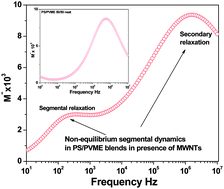Non-equilibrium segmental dynamics driven by multiwall carbon nanotubes in PS/PVME blends
Abstract
The present paper discusses the effect of multiwall carbon nanotubes (MWNTs) on the structural relaxation and the intermolecular cooperativity in dynamically asymmetric blends of PS/PVME (polystyrene/poly(vinyl methyl ether)). The temperature regime where chain connectivity effects dominate the thermodynamic concentration fluctuation (T/Tg > 0.75, Tg is the glass transition temperature of the blends) was studied using dielectric spectroscopy (DS). Interestingly, in the blends with MWNTs a bimodal distribution of relaxation was obtained in the loss modulus spectra. This plausibly is due to different environments experienced by the faster component (PVME) in the presence of MWNTs. The segmental dynamics of PVME was observed to be significantly slowed down in the presence of MWNTs and an Arrhenius-type behavior, weakly dependent on temperature, is observed at higher frequencies. This non-equilibrium dynamics of PVME is presumed to be originating from interphase regions near the surface of MWNTs. The length scale of the cooperative rearranging region (ξCRR) at Tg, assessed by calorimetric measurements, was observed to be higher in the case of blends with MWNTs. An enhanced molecular level miscibility driven by MWNTs in the blends corroborates with the larger ξCRR and comparatively more number of segments in CRR (in contrast to neat blends) around Tg. The configurational entropy and length scale of the cooperative volume was mapped as a function of temperature in the temperature regime, Tg < T < Tg + 60 K. The blends phase separated by spinodal decomposition which further led to an interconnected PVME network in PS. This further led to materials with very high electrical conductivity upon demixing.


 Please wait while we load your content...
Please wait while we load your content...